
- Home Page
- Accepted
Paintings & Copies - Doubtful
Attributions - Doubtful Textual References
- Alternative
Titles - Collectors &
Museums - Bibliography
- Search Abecedario
- Watteau &
His Circle
L’Amour paisible
Entered March 2015 ; revised November 2020

Presumed lost
Probably oil on canvas
61 x 72 cm
ALTERNATIVE TITLES
A Pastoral Conversation
RELATED PRINTS
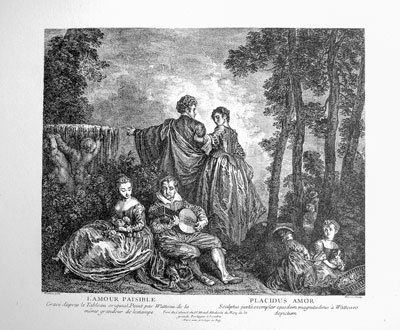
The painting was engraved in reverse by Bernard Baron in London, probably in the 1720s. The engraving was incorporated into the Jullienne Oeuvre gravé.
PROVENANCE
London, collection of Dr. Richard Mead (1673-1754, doctor to King George II). His sale, London, March 20-22, 1754: “A Pastoral CONVERSATION by Watteau. Two feet by two feet six inches.” Bought by Thomas Whood for £42, according to an annotated copy of the catalogue in an unidentified English(?) library. It would seem that Whood was acting as an agent for Francis Beckford. In his transcription of the Mead catalogue, Houlditch, Sale Catalogues of the Principal Collections, identified the buyer of L’Amour paisible as “Beckford.”
London, with Thomas Wood (1708-1799; art dealer?).
London, collection of Francis Beckford (d. 1768).
London, collection of Roger Harenc (1693-1763). His sale, London, Langford, March 1-3, 1764 (3rd day), lot 52: “WATTEAU . . . A musical Conversation, and Italian Comedians, its Companion.” Sold for £8.18 to the duke of Grafton, according to an annotated copy of the sale catalogue in the Rijksbureau voor Kunsthistorische Dokumentatie.
SELECT BIBLIOGRAPHY
Hédouin, “Watteau” (1845), cat. 109.
Hédouin, Mosaïque (1856), cat. 110.
Goncourt, Catalogue raisonné (1875), cat. 102.
Dacier, Vuaflart, and Hérold, Jean de Jullienne et les graveurs (1921-29), cat. 268.
Miller, “Borrowings of Watteau” (1927), 38, 43.
Réau, “Watteau” (1928), cat. 162.
Adhémar, Watteau (1950), cat. 126.
Mathey, Watteau, peintres réapparues (1959), 69.
Mirimonde, “Sujets musicaux chez Watteau” (1961), 270-71.
Macchia and Montagni, L’opera completa di Watteau (1968), cat. 197.
Ferré, Watteau (1972), 1: 147, 1754, 1755, 1764; 4: 1107.
Raines, "Watteaus and 'Watteaus' in England" (1977), 57, 62.
Washington, Paris, and Berlin, Watteau 1684-1721 (1984), under cat. D89-90.
Roland Michel, Watteau (1984), 230.
Rosenberg and Prat, Watteau, catalogue raisonné des dessins (1996), 1: cat. 333, 353; 2: 527, 553, 559, 636.
Glorieux, Watteau (2011), 318.
London, Royal Academy, Watteau, the Drawings (2011), 27-28.
Vogtherr, Watteau at the Wallace Collection (2011), 116-17.
Brussels, Palais des beaux-arts, Watteau, Leçon de musique (2013), cat. 16-18.
RELATED DRAWINGS
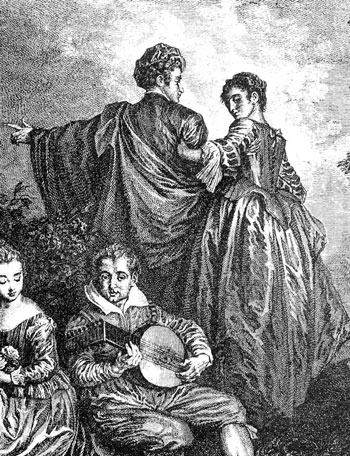
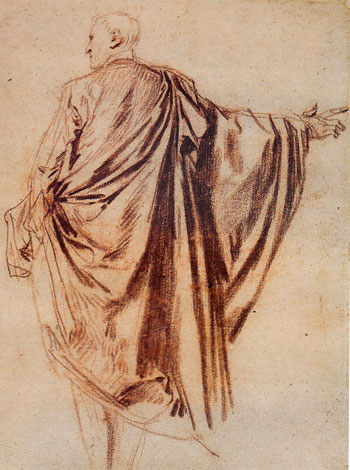
Watteau, Study of a Standing Man, red chalk, 17.2 x 12.6 cm. Paris, private collection.
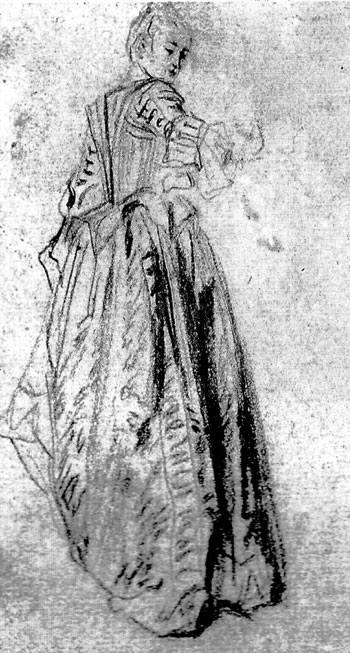
Watteau, Two Studies of Women (detail), graphite. Private collection.
There are extant drawings for most of the figures in L’Amour paisible. The couple standing at the center of the painting is derived from two separate studies, as one might have expected. The man is taken from a sheet now in a Parisian collection (Rosenberg and Prat 636), where the model appears bareheaded. In the painting the same figure wears a beret and his facial features have been altered. The standing woman appears on a sheet with two studies of the same model (Rosenberg and Prat 527).
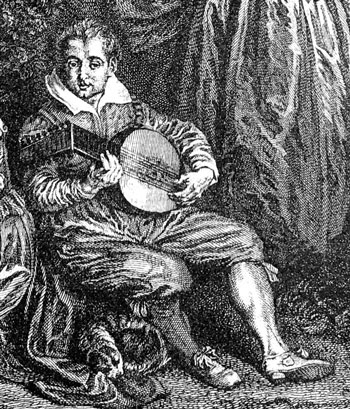
Bernard Baron after Watteau, L’Amour paisible (detail), engraving.
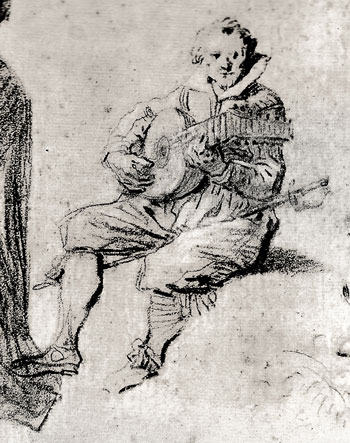
Watteau, Studies after Van de Venne and Another Sixteenth-Century Painting (detail), red chalk. The Netherlands, private collection.
Watteau similarly joined two separate sources for the couple seated in the foreground. The drawing for the woman seems not to have survived, but one can easily imagine the type of sheet with several studies of the posed model. The source of the figure of the lutenist is more unusual: it is a sheet with two different figures that Watteau copied from a picture then in the French royal collection, the Celebration Given in Honor of the 1609 Peace Treaty, painted by Adriaan Pieter van de Venne (Rosenberg and Prat 353). Whereas Watteau faithfully imitated this musician and the nearby servant with bottles of wine in his drawing, he modified the appearance of the lutenist in his painting, giving him a younger, beardless face. While Watteau relished archaic fashions in dress, he carefully eschewed the old style of beards and moustaches, and removed the gentleman’s sword.
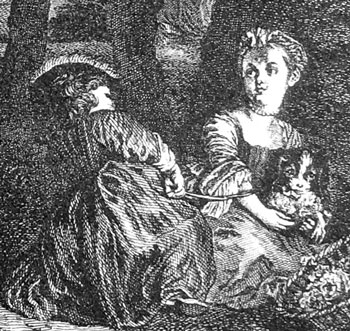
Bernard Baron after Watteau, L’Amour paisible (detail) engraving.
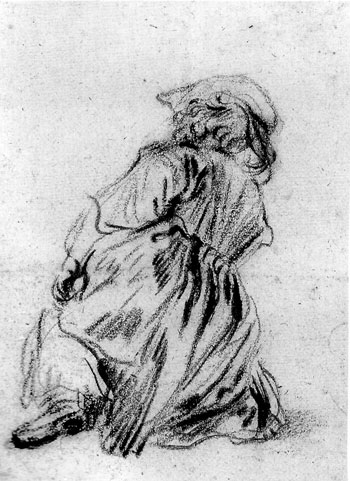
Watteau, Study of a Kneeling Child Seen from Behind, red chalk, 13.3 x 10 cm. London, British Museum.
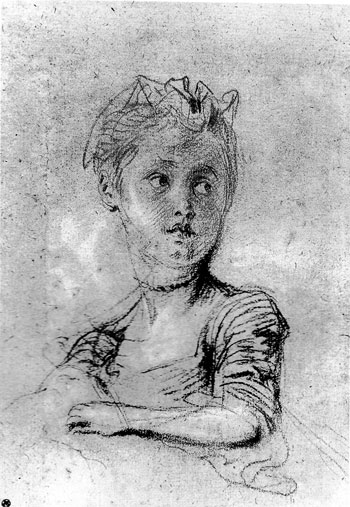
Watteau, Study of a Young Girl, red chalk, black chalk, and white chalk, 17.7 x 12.3 cm. Orléans, Musée des beaux-arts.
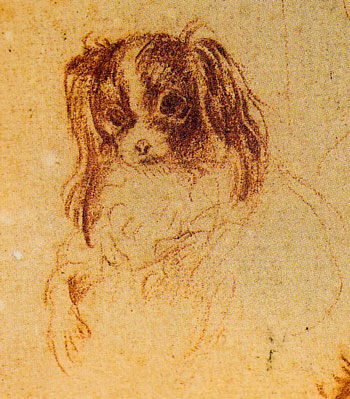
Watteau, Studies of a King Charles Spaniel (detail), red chalk. Fontainebleau, private collection.
Similarly, the children in the foreground were derived from several unrelated studies. The one seen from behind was taken from a sheet now in the British Museum that, judging from its small size, was once part of a larger sheet with studies of this child (Rosenberg and Prat 333). The torso and head of the girl posed frontally were borrowed from a sheet in the Musée des beaux-arts in Orléans (Rosenberg and Prat 559), and the dog she holds in her arms came from a sheet now in a private collection in Fontainebleau (Rosenberg and Prat 553).
The one noticeable lacuna is the drawing that was used for the woman in the foreground of L'Amour paisible. Although Watteau made many studies of women in comparable poses (e.g., Rosenberg and Prat 391 and 468), and there are also related studies of women’s heads (Rosenberg and Prat 562 and 609), the actual drawing that Watteau used seems not to have survived.
REMARKS
In regard to the early provenance of Les Comédiens italiens, Robin Simon has kindly clarified the identity of “Wood,” the buyer of the painting at Dr. Mead’s sale. He was Thomas Wood of Littleton Park, Staines, Middlesex. On a previous occasion, in 1745 at the Hogarth sale, he bought that painter’s Actresses Dressing in a Barn, and the following day sold it to Beckford (see Elizabeth Einberg, William Hogarth, A Complete Catalogue of the Paintings (New Haven and London: 2016), cat. 103. Evidently the two men had an understanding between them.
Although lost from sight since the eighteenth century, L’Amour paisible occupies a special place in Watteau’s oeuvre because it is one of the few paintings that he executed while he was in England from late 1719 until mid-1720. Thus it is a crucial marker in trying to fix Watteau’s ever-evasive chronology. (Ferré, always the exception, finds the composition heavy and awkward, and claims that the attribution to Watteau is unsustainable—an opinion that has no merit.) Moreover, L’Amour paisible was owned by Dr. Richard Mead, one of England’s leading doctors and an important patron of the artist when he was in London.
The general tendency has been to date L'Amour paisible to 1719-20 due to its association with Mead and Watteau’s visit to London. This raises the intriguing question of which drawings were new ones made in the English capital and which were older studies brought from Paris. The telling work is the sheet that depicts the lutenist; it had to have been drawn in Paris since it copies the van de Venne painting that was then in the French royal collection. Rosenberg and Prat would date it to 1715 whereas Grasselli prefers 1717. But, whatever date is assigned, it was evidently drawn prior to mid-1719 when Watteau left for England.
Other drawings associated with L’Amour paisible have been dated earlier than 1719 but without the same level of proof. Rosenberg and Prat, for instance, dated the drawing of the girl seen from behind to 1715 and the one of the girl seen frontally as well as the dog and the sheet with the standing woman to 1717. Yet these dates are merely opinions and are contested. Grasselli, for example, proposed that the drawing of the girl seen from behind and the sheet with the standing woman were created in 1719.
Ferré introduced a hypothesis regarding the provenance of L’Amour paisible and Les Comédiens italiens. He proposed that the two works could be identified with a pair of Watteau paintings, identified as A Small Landscape and Italian Comedians that were sold from the Rontgen collection in 1755, where they were identified as A Musical Conversation and Italian Comedians. However, as L’Amour paisible measured 61 x 72 cm, the epithet “small” does not seem fitting.
For copies of L’Amour paisible, CLICK HERE